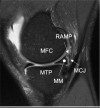Ramp Lesions of the Medial Meniscus
- PMID: 37014609
- PMCID: PMC10188848
- DOI: 10.1007/s12178-023-09834-2
Ramp Lesions of the Medial Meniscus
Abstract
Purpose of review: To provide an overview of the recent scientific literature about ramp lesions of the medial meniscus and to summarise the current evidence on their prevalence, classification, biomechanics, surgical techniques and clinical outcomes.
Recent findings: Ramp lesions may be present in more than 1 patient undergoing ACL reconstruction out of 5 and almost half of the medial meniscal tears observed in this population. Due to the risk of persistent anterior and rotational laxity after ACL reconstruction, their repair has been advocated. There is no general agreement to date on whether and when ramp lesions should be treated surgically. Comparative studies have failed to show that the repair of stable lesions was superior in comparison to nonoperative approaches. A lower failure rate and secondary meniscectomy has been reported with a suture hook repair through the posteromedial portal in comparison with an all-inside technique. Furthermore, reconstructions of the anterolateral complex in association with ACL reconstruction may have a protective effect on ramp repair. Ramp lesions of the medial meniscus in ACL-injured knees cannot be neglected anymore. Given their novelty, their clinical impact has not been fully assessed yet, but the evidence is growing that they need to be systematically identified and eventually repaired, for which they require advanced surgical knowledge. There is, to date, no consensus on whether and when ramp lesions should be treated surgically. Their subtypes, size and stability may influence the decision-making process.
Keywords: ACL; Medial meniscus; Outcomes; Prevalence; Ramp lesion; Repair.
© 2023. The Author(s), under exclusive licence to Springer Science+Business Media, LLC, part of Springer Nature.
Conflict of interest statement
The authors declare no competing interests.
Figures







References
-
- Lemaire M, Combelles F, Miremad C, Van Vooren P. Postero-internal menisco-capsular disinsertions associated with chronic instabilities of the knee caused by rupture of the anterior cruciate ligament. Rev Chir Orthop Reparatrice Appar Mot. 1984;70(8):613–622. - PubMed
Publication types
LinkOut - more resources
Full Text Sources
Research Materials

